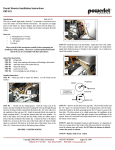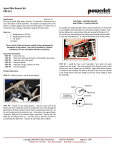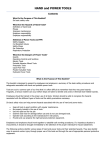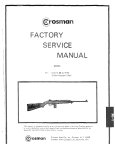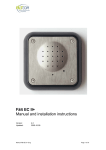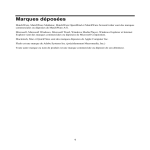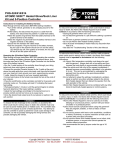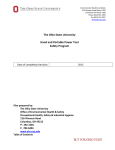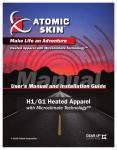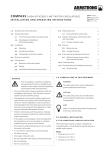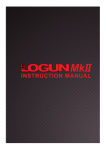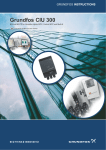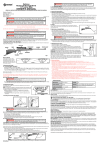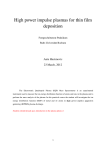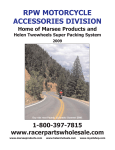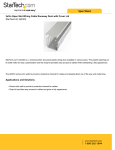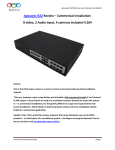Download The QB78 CO2 Pellet Rifle - Airrifle.co.za ¤ Passionate About Air Rifles
Transcript
The QB78 CO2 Pellet Rifle A User’s Manual Text, photos and illustrations by George Fox Lang An introduction to using the classic QB78 pellet rifle, one of the nicest and most popular CO2 rifles ever produced. The QB78 is a svelte sculpture in steel and hardwood sold at a bargain price. It provides low-priced entry to the world of precision airguns and unending opportunities for the adventurous experimenter. © George Fox Lang, 2006 – All Rights Reserved Neither this manual nor any of its content may be reproduced or copied, for any commercial purpose, without the written consent of the author. Distributed exclusively by Flying Dragon Air Rifles About the QB78 The QB78 is a modern classic manufactured by the Shanghai Air Gun factory and sold worldwide under the Industry brand. It is a compact and handsome CO2-powered rifle made of blued-steel and hardwood. It is a manly weapon with nothing “toy-like” or plastic about it. The QB78 exhibits power and accuracy matching its good looks. It was patterned after the no longer manufactured Crosman 160 and 167 airguns. SPECIFICATIONS Type: single-shot, bolt action Caliber: .177 (4.5 mm) or .22 (5.5 mm) Muzzle Velocity: 600 FPS (.177) or 420 FPS (.22) typical within 60° to 80°F Accuracy: 0.5 inch center-to-center at 10 yards typical Trigger: Single-stage; adjustable for tension, over travel, sear engagement Sights: open iron sights; rear adjustable for elevation; 17.5” sight radius Barrel: 21.4 inch (543 mm), target grade steel Energy Source: two 12-gram CO2 Powerlet® cartridges Stored Energy: typically sufficient for 50-60 full-power shots Length Overall: 40 inch (1015 mm) Length of Pull: 14 in (355 mm) Weight: 5.75 lb (2.6 kg) Powerlet is a registered trademark of the Crosman Corporation Setup Before using your new rifle, inspect it carefully to assure that all parts and accessories are present and that no shipping damage has occurred. Retain the shipping container and packing, in the event that subsequent service is required. Be certain the rifle is unloaded, before doing anything else! Check to see that the bore is unobstructed. Be certain the gas tube cap can be turned by hand. Verify the bolt, trigger and safety functions. 2 Operation - Installing CO2 Cartridges 1. Verify that the Gas Tube Cap can be loosened by hand, as shown above. Never use a tool to rotate this cap. A tight cap indicates dangerously high gas pressure remains within the Gas Tube. 2. Apply the Safety by swinging it to the rear as shown above. 3 3. Open the Bolt as illustrated above. Opening the bolt leaves the loading chamber open to inspection. More importantly, retracting the bolt prevents dangerous accidental piercing of the rearward-facing CO2 cartridge. 4. Unscrew the Gas Tube Cap from the Gas Tube and set it aside. Slide two 12-gram CO2 cartridges into the Gas Tube back-toback as shown above. Note, for shorter shooting sessions, load an empty cartridge as the rearward-facing (first installed) cartridge. This will give approximately 30 full-power shots. 5. Screw the Gas Tube Cap back on fully; this will pierce the forward-facing CO2 cylinder. When the cap has seated fully hand-tight, back it off a quarter-turn. This will allow the CO2 to flood the Gas Tube. Do not forget to back off or the forward-facing cartridge will remain sealed by the Gas Tube Cap. 6. Check that the chamber is clear. Operation - Shooting Basic operation of the rifle is very simple. To fire a pellet: 7. 8. 9. 1. Lift the Bolt Handle and pull it fully to the rear to open the breech. 2. Insert a pellet of the proper caliber into the open breech. Make certain the pellet enters nose-first with the fan-tail skirt to the rear, as shown. 3. Push the Bolt Handle fully forward and rotate it down. This seats the pellet into the rifling and seals the breech. The weapon is ready to fire. 4. Aim at your target, place your trigger finger within the Trigger Guard and squeeze the Trigger gently. Close the Bolt, cocking the rifle. Release the Safety, by rotating forward and out of the trigger guard. Point the rifle in a safe direction and pull the trigger. A mild report ‘pop’ verifies the weapon is now charged with CO2 and is ready for shooting. 4 Trigger Adjustments 2. Unscrew the Locating Screw Nut and remove the action from the stock. 3. Use a #2 Phillips-head screwdriver to remove the two Casing Plate Screws. Lift off the Casing Plate to expose the trigger mechanism. 4. Use a 2 mm flat jeweler’s screwdriver to adjust the Sear Engagement and Overtravel screws. Use a 3/16” flat screwdriver to adjust the Tension screw. 5. Reassemble the rifle by following these instructions in reverse sequence. The QB78 trigger features three adjustments: A – Tension or trigger force factory set to about 4 lbs turn screw counter-clockwise to reduce Setting tension below 2 lbs may result in accidental discharge if the rifle is dropped. B – Over travel or backlash factory set to about 0.25” turn screw clockwise to reduce Turning screw too far clockwise will prevent the rifle from firing. C – Sear Engagement or pull length factory set at about 0.125” turn screw clockwise to reduce Reduced sear engagement may result in accidental discharge if the rifle is dropped. To Make Trigger Adjustments Unload the rifle before making adjustments. 1. Place the Safety lever in the SAFE position and push it out of the Trigger Casing from left-to-right. Use the eraser-end of a wooden pencil as the dismounting tool. 5 Mounting a Scope One of the most popular options for any airgun is a telescopic sight. The QB78 is an accurate rifle and it fully deserves a good quality optical sight. If possible, choose a scope with an Adjustable Objective (AO). This is a second focusing adjustment, allowing the scope to be used at close distance (10 yards or less). (The first focusing adjustment is for the eyepiece and it compensates for your eye.) Your QB78 has receiver grooves that will accept ‘standard’ 11 mm airgun or airgun/rimfire rings. (Note that these are different from Weaver mount rings.) For best results, use the lowest saddle height rings possible. This keeps the scope axis as close to the bore axis as possible. 1. Prepare the rings for application. If they contain recoil stop-pins, remove them as the QB78 has no mating stop-pin holes. Remove the caps from the ring bases. 2. Mount the bases to the receiver. Only handtighten the clamp screws; you need the bases to slide freely at this point. 6 3. Fit the scope into the bases. Slide one of the bases until the spacing is ‘right’ about the scope’s central turret. Add the ring caps, but only hand-tighten their screws. 4. Hold the rifle in firing posture. Slide the scope back and forth until you achieve a position that lets you see through the optic with the least “tunnel vision”. Lock the base screws at this location. Twist the scope body to align the graticule vertical line up and down. Then tighten the cap screws. Optical Adjustments 5. If necessary, use a #2 Phillips screwdriver to remove the two screws securing the rear iron-sight. Save these pieces for future use. 1. 6. 7. Install scope accessories such as filters, sunshades, and lens caps. Note: when fitting a short or ‘mini’ length scope, (such as the Leapers 6x32 Bugbuster illustrated) you may have to compromise this position to leave the breech clear of the scope’s front bell. If desired, use a 1/8” flat-bladed screwdriver to remove the front sight. 2. Focus the eyepiece or ocular adjustment to provide a crisply defined graticule. Viewing an uncluttered target such as a light-colored painted wall makes this adjustment simplest. 3. Set up a target at the desired shooting distance. Focus the front-bell (or side-wheel) parallax adjustment to provide a clear image of the target. When both the graticule and the target are in sharp focus, the two images are in the same plane within the scope. This allows your eye position to move without affecting the point of aim. 4. 8. Physically position the scope fore-and-aft from your eye. When properly positioned, the scope will present a full field of view, free of “tunnel vision”. Your eye is now within the eye relief of the scope. Adjust the windage and elevation of the scope to force the point-of-impact to converge with the point-of-aim. Do this as an iterative process, starting at close range and incrementally moving back to your desired target range. Use care not to over-torque the small base and cap mounting screws provided with your scope rings. Only hold the short side of your Allen wrench when tightening scope screws. Zero the scope to the rifle by firing from a steady rest. Start at a close distance and work out. 7 Theory of Operation The following figures are not scale drawings of the QB78 parts; they are schematic diagrams intended to explain how the rifle functions. Some artistic liberties have been taken for clarity of explanation. ARRANGEMENT OF PARTS The Breech Tube (1) contains the Bolt (2) and is attached to the Barrel (3) by a setscrew and O-rings. It sits atop the Gas Tube (4) to which it is screwed. An O-ring seals a gas transfer path between the Valve Body (8) contained in the Gas Tube and the firing chamber sealed by an O-ring on the Bolt. The Gas Tube (4) holds two CO2 cartridges (5) back-to-back. The reward-facing cartridge is in front of the Piercing Pin (6), the Valve Stem (7) and the Valve Seat (8). A Valve Spring (9) surrounds the Piercing Pin and reacts against it and a fixed spacer. The rear of the Gas Tube houses the Hammer (10) and Cocking Piece (11). These parts are surrounded by the Hammer Spring (12), which reacts against both of them. Note that pins are fitted to the Hammer and Cocking Piece. These pins connect these parts mechanically with the Bolt, through facing slots in the Breech Tube and the Gas Tube. The spring supported Sear (13) protrudes into the Gas Tube from the Trigger Casing Assembly, screwmounted to the bottom of the Gas Tube. The sear is a cam-like device that can hold the Hammer in a rearward position until the Trigger causes it to fall away. As shown above, the rifle has been fired and the bolt remains closed on an empty chamber. Both the Hammer Spring and the Valve Spring are in their relaxed (but preloaded) conditions. CO2 gas fills the front portion of the Gas Tube but is blocked from further infiltration by the Valve Stem pressed firmly against Valve Seat by the Valve Spring. The Hammer rests upon the Valve Stem in this equilibrium. OPENING THE BOLT Raising its handle and pulling the Bolt (2) to the rear moves the Hammer rearward through action of the Hammer Pin. The modest compressive preload of the Hammer Spring is retained against the bolt through the Cocking Piece Pin. With the Bolt open, a pellet can be placed in the mouth of the firing chamber. 8 CLOSING THE BOLT Pushing the Bolt forward (and lowering its handle) cocks the weapon and locks the pellet in the firing chamber, ahead of the gas transfer port. The pellet is forced into the Barrel’s twisted grooves and the Oring on the Bolt seals the chamber behind it. As the Bolt moves forward, the Hammer and Cocking Piece follow it. Forward motion of the Hammer is arrested by the Sear, which stops the Hammer about 7/16” before it can contact the Valve Stem. The Cocking Piece moves forward about an inch, compressing the Hammer Spring. The rifle is now ready to fire. FIRING THE RIFLE Squeezing the Trigger causes the Sear to fall, allowing the Hammer to move forward rapidly under pressure of the Hammer Spring. The Hammer impacts the Valve Stem and is then arrested by a stop spacer and the back of the Valve Seat. The Valve Stem continues forward, opening the Valve Seat and transfer port to an inrush of CO2 gas. The Valve Stem continues its forward travel, driving the Piercing Pin forward and compressing the Valve Spring. The pellet is launched by the released gas and starts its journey, spinning down the Barrel. The Piercing Pin is driven into the welded seal of the rearward-facing CO2 cartridge, piercing it (if it is still sealed). Note that the foreward-facing CO2 cartridge is pierced during loading, by a separate piercing pin in the tube cap. A FEW MILLISECONDS AFTER FIRING The compressed Valve Spring eventually extracts the Piercing Piece from the CO2 cartridge and presses it back against the Valve Stem, which is forced back against the Valve Seat. This stops the flow of gas just as the pellet is about to exit the Barrel and the starting conditions are reestablished. 9 About CO2 Your QB78 rifle uses two common 12-gram Powerlet® CO2 cartridges. This is sufficient energy for about 60 full-power shots if used within a temperature range of about 60 to 80 °F. 100 90 Liquid 80 Percent Mass 70 The Powerlet wraps 31.5 grams of deep-drawn steel around 12 grams of liquid and gaseous carbon dioxide (CO2), locking it in a hermetically sealed vault with a minimum burstpressure of 7000 pounds per square inch (psi) pressure. The bottle is smooth and seamless, providing a precisely controlled 14 cc volume sealed by a pierceable steel plug welded to the bottle’s neck. 60 50 40 30 20 Gas 10 0 0 20 40 60 80 100 120 140 160 Temperature (° F) The critical temperature of CO2 is 87.8° F and this temperature is of particular importance to air-gunners. As shown in the graph above, below this temperature both gas and liquid CO2 coexist in the Powerlet. Above this temperature, only gas can be present. The cartridge exhibits a natural pressure-regulating mechanism, but only at temperatures lower than 87.8° F. SECTIONED VIEW OF A POWERLET At low temperature, the bulk of the entrained CO2 is in liquid state. As the ambient temperature rises, heat enters the cartridge and some of the liquid boils to gas; the percentage of gas in the mixture increases, as does the pressure. Below 87.8° F, the boiling stops when the pressure reaches the vapor pressure determined by the ambient temperature as long as some liquid remains. Above this critical temperature, all the CO2 boils to gas. The Powerlet contains a considerable amount of energy (over 280 ft-lb or 380 Joule). This is approximately equivalent to two high-velocity .22 long-rifle shells, or one .38 Special (+P) cartridge. To place this in another perspective, the contained energy is sufficient to light a 100Watt bulb for nearly four seconds. Any one of these equivalents is clearly capable of injuring you; the CO2 cartridge must be treated with care and respect! When a shot is made, some CO2 gas exits the cartridge rapidly and the ratio of gas-to-liquid is instantaneously reduced. The loss of gas reduces the pressure within the cartridge, causing some of the liquid to boil or vaporize to “fill the void”. This vaporization extracts heat from the mixture, cooling it. When used near room temperature, it is capable of delivering most of this stored energy as useful muzzle energy. Fifty (slow fired) shots of 600 foot per second (fps) velocity with a 7.1 grain pellet (5.7 ft-lb muzzle energy) is a reasonable expectation. The mixture continues to boil liquid to gas, increasing the pressure while drawing heat from the ambient temperature surroundings. Eventually, the mixture warms back to the ambient temperature and the boiling stops when the pressure reaches the vapor pressure. Hence the next shot will be made from exactly the same pressure source. This is the natural pressureregulation mechanism provided by CO2. If the firing pace is slow and deliberate, these shots will exhibit remarkably consistent velocity, owing to the “built-in pressure regulation”, provided by thermodynamic interplay between the liquid and gas phases of CO2. Powerlet is a registered trademark of Crosman Corporation 10 When the cartridge is nearly depleted, the transition point marks the end of useful life. This is the point at which all of the liquid CO2 has been consumed. Consider what happens when a mass of CO2 is sealed in a fixed-volume container. If the massto-volume charge density is equal to the 0.468 g/cc critical density, the pressure within the container will exactly equal the vapor pressure for any temperature below the 87.8° F critical temperature. If a larger (or smaller mass) of CO2 is present, the pressure-versus-temperature line will depart from the saturation line at a temperature below 87.8° F, as shown below. Re-plotting this data with a different format makes the natural regulation process more evident. The following plot presents a family of pressure-versus-mass lines, each for a different ambient temperature. Note the broad constantpressure (horizontal) segment in each line below the (dotted) 87.8° F curve. CO2 Rem aining 6000 12 5000 4000 10 3000 Pressure (psig) Pressure (psig) 11 8 6 2000 4 2 1000 1 0 0 20 40 60 80 100 120 140 160 Temperature (° F) Tem perature (° F) 1500 1400 1300 1200 1100 1000 900 800 700 600 500 400 300 200 100 0 100 90 80 70 60 50 40 30 20 0 1 2 3 4 5 6 7 8 9 10 11 12 Co2 Remaining in 12-gram Powerlet (g) This figure presents the pressure within a Powerlet as a function of temperature with from 1 to 12 grams of CO2 remaining in the bottle. Note the blue segment partially common to all of these traces; this is the saturation line. A CO2 charge of 6.55 grams remaining in the 14 cc cartridge volume (0.468 g/cc) will exhibit a pressure-versus-temperature curve that follows the saturation line all the way to 87.8° F; all other charges depart from the blue line at a lower temperature. CO2 regulation is summarized below. Mark the ambient temperature on the horizontal scale and read the corresponding pressure and mass limits directly above it. For example, on a 70° F day, a regulated pressure of 840 psig will be provided as long as the Powerlet holds at least 2.8 grams but not more than 10.6 grams of CO2. Hence the first few shots will be “hot” until you use 1.4 grams from a new Powerlet. You will “run out of liquid” when 2.8 grams of gas remain in the cartridge. The point of departure from the blue segment is termed the transition point, defining a transition temperature and a transition pressure. Above the transition temperature, the CO2 behaves as a gas with pressure rising with increasing temperature. When the Powerlet is essentially full, the slope above the transition point is very steep and pressure rises rapidly with temperature to potentially dangerous levels. 13 12 11 10 9 8 7 6 5 4 3 2 1 0 M aximum C O 2 f o r R eg ul at ed Pr essur e M inimum C O 2 f o r 40 45 50 55 60 65 70 75 80 85 90 Tem perature (° F) 11












